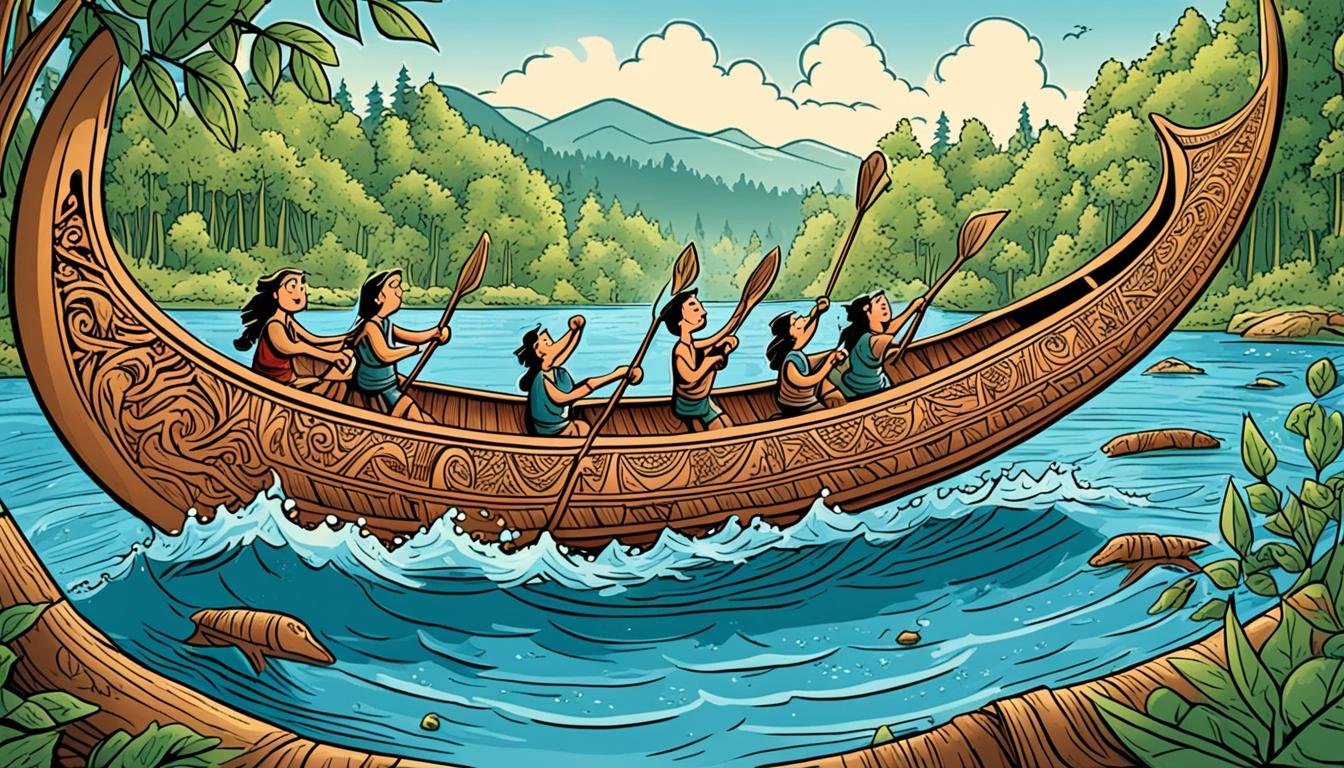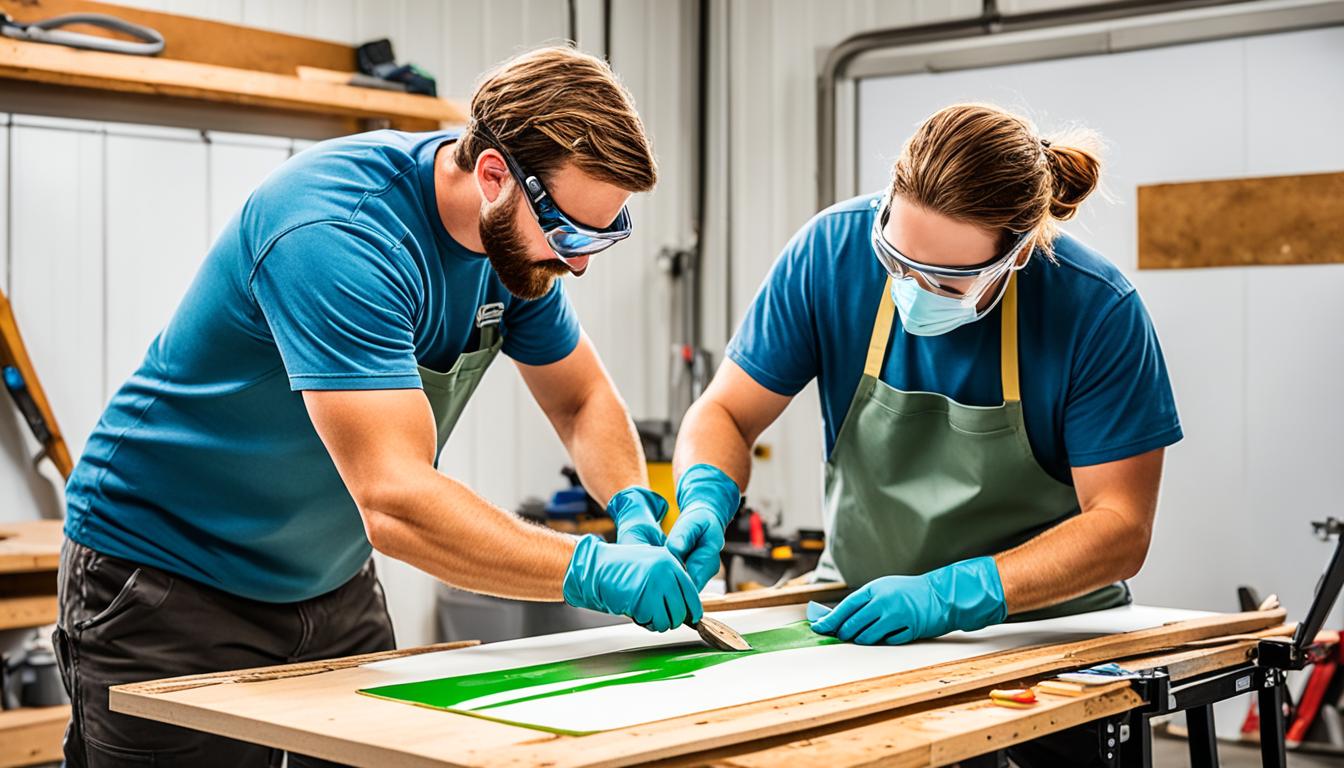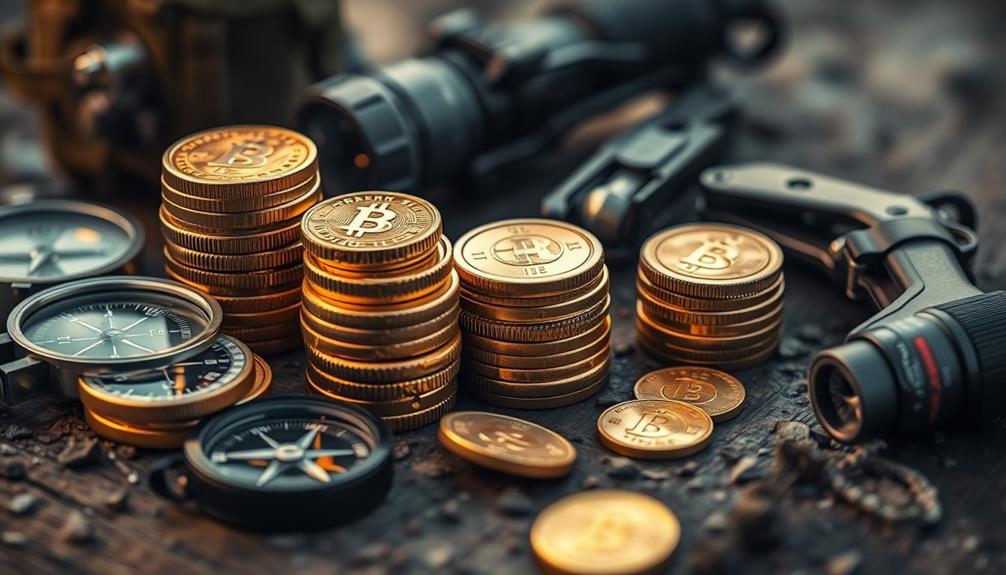Have you ever thought about how ancient people traveled over water? They used rivers and lakes to find new places and explore. The key to their travel was the canoe, one of the oldest boats made by humans.
When we look into the history of canoes, we find a story that goes back thousands of years. It links us to our ancestors’ creativity. Making canoes was a big achievement that helped early people live and grow.
Picture yourself long ago, standing by a peaceful river. The sun shines on the water. You see an ancient group making canoes with excitement. They made these boats from what nature offered them.
Key Takeaways:
- The origins of canoes go back to ancient people.
- Canoes were key for moving around, getting food, and fighting.
- People made canoes from wood, bark, and animal skins.
- Groups like the Amerindians in the Caribbean and tribes in North America advanced canoe making.
- Digs have found canoes from as far back as 8200 BC.
Oldest Canoes and Their Construction
Canoes have been around for thousands of years. They show us how clever early civilizations were. They were really good at building boats.
The Pesse Canoe is one of the oldest, from around 8200 BC in the Netherlands. They were carved out of a single log. People used them for catching fish and getting around.
In Nigeria, the 8500-year-old Dufuna Canoe was found. It is very old too. It was also carved from one tree. This shows the amazing skills of ancient cultures.
Different parts of the world had their own ways of making canoes. For example, the Amerindians in the Caribbean used bark, animal skins, and reeds. They knew how to make their canoes light and strong.
To make canoes from bark, ancient builders would peel it off certain trees. Then they shaped, stitched, and waterproofed it. Canoes from animal skins were sewn tight and made watertight.
Old canoes were often slim and had points at both ends. This made them fast and easy to steer. Their open design made carrying things or people simple.
Early builders were smart and could use what was around them. They made boats that worked well for their needs.
https://www.youtube.com/watch?v=vr_bZkbJnto
Ancient Canoe Materials and Construction Techniques
| Canoe Type | Materials | Construction Techniques |
|---|---|---|
| Pesse Canoe | Wood (single piece) | Hollowed out tree trunk |
| Dufuna Canoe | Wood (single piece) | Hollowed out tree trunk |
| Amerindian Canoes | Bark, animal skins, reeds | Peeling, stitching, waterproofing (bark canoes); sewing, treating (animal skin canoes) |
Canoes in Pre-Columbian Caribbean and North America
Canoes have a deep history in the Pre-Columbian Caribbean and North America. These boats were crucial for exploration, settling, and daily activities of early civilizations.
Around 3500 BC, different Amerindian groups settled in the Pre-Columbian Caribbean islands. They heavily relied on canoes to move across waters and build island communities. These single-hulled canoes made it possible to journey between the mainland and islands.
In North America, Native American tribes used canoes for many things. They made dugout canoes by carving out large trees. This created strong boats for transport, fishing, and hunting. Canoes helped them travel through rivers and lakes for trade, food, and exploring.
Navigating the Caribbean Sea:
The early Amerindian peoples were master sailors of the Caribbean Sea thanks to their canoes. These boats let them hop between islands, trade goods, share cultures, and meet other communities.
Ancient Transportation and Exploration:
Canoes in the Pre-Columbian Caribbean were key for amazing navigational feats. With them, people found new places and connected with other cultures. They were essential for exploring and settling the Caribbean islands.
In both the Caribbean and North America, canoes played a big role for ancient people. They allowed for movement, trade, and discovery. Canoes helped shape the culture and growth of these regions during early times.

Kayaks: A Unique Watercraft
Kayaks catch the eye as a unique invention in the world of watercraft. Different from canoes, they have their own origin and build. Let’s delve into the history, creation, and features of these amazing Arctic boats.
While people worldwide used canoes, kayaks came from the Greenlandic Eskimos. The name “kayak” means “man-boat” in their language. It was mainly for hunting and fishing in cold Arctic waters. These boats have been around for thousands of years, showing they are among the oldest means of water transport.
The making of kayaks shows real human genius. Crafted traditionally, they used animal skins over a wooden or bone frame. This made them light and strong. They could move smoothly in water, perfect for the Arctic’s tough conditions.
Unlike canoes, kayaks have a closed top. This keeps the paddler warm and dry, and helps the kayak stay stable and easy to steer. If water gets in, it’s easier to get it out because of this design.
Kayak paddles are special too. They have two blades, so you can paddle easily on both sides. This helps with moving through tight spots and avoiding things in the water.
Kayaks were very important for Arctic people. They could go through dangerous waters, find food, and explore ice-covered areas. Now, kayaking is a fun activity many people enjoy all over the world.
“The kayak’s origins can be traced back thousands of years, making it one of the oldest known forms of water transportation.”
Kayaks are interesting because of their unique background and how they are made. They show how inventive humans can be. Kayaking lets you feel the excitement of water, whether it’s a calm lake or wild rapids.

| Kayak Origins | Arctic Watercraft | Kayak Construction |
|---|---|---|
| Originated from Greenlandic Eskimos | Specially designed for Arctic hunting and fishing | Made with animal skins and wooden frames |
| Thousands of years of historical significance | Resilient and maneuverable in icy Arctic waters | Closed cockpit design for improved stability |
| Utilizes double-blade paddle for efficient propulsion |
Evolution of Canoe and Kayak Materials
Canoe and kayak building materials have changed a lot over time. These changes have made them better for sports and fun activities. Now, they are more efficient and versatile than ever.
Long ago, people used natural materials to make canoes and kayaks. Cultures around the world used wood, bark, and animal skins. This made the boats light and strong for rivers and lakes.
In the early 20th century, canoes had a wood frame covered with canvas. This made them look good. But, they needed a lot of care to stay in good shape.
Then, aluminum became popular for canoe making. It was light and didn’t rust or rot. Aluminum canoes were great for adventures in the outdoors.
Later, molded plastic changed canoe and kayak making. It was cheap, tough, and easy to take care of. Many people liked these boats for fun paddling.
Composites like fiberglass, kevlar, and graphite were a big step forward. They made boats strong, light, and flexible. Boats made from fiberglass were easy to steer in different waters.
Kevlar and graphite made boats even better. Kevlar boats were super strong and perfect for tough waters. Graphite made boats fast and easy to control.
The new materials have opened up new opportunities. Now, paddlers can go to far-off rivers, enjoy challenging rapids, and paddle easily. Modern boats let everyone have more fun on the water.

| Material | Advantages | Disadvantages |
|---|---|---|
| Wood | Natural aesthetic, lightweight | Regular maintenance required |
| Canvas on Wood Frame | Streamlined design | Prone to water damage |
| Aluminum | Lightweight, corrosion-resistant | Poor insulation, conducts heat/cold |
| Molded Plastic | Affordable, durable | Not as responsive as composites |
| Fiberglass Composite | Strength, lightness, maneuverability | Can be prone to scratches |
| Kevlar Composite | Exceptional strength, lightweight | Higher cost |
| Graphite Composite | Stiffness, responsiveness, speed | Higher cost, less impact resistance |
The International Canoe Federation
The International Canoe Federation (ICF) started in 1924 as Internationale Repräsentantenschaft Kanusport (IRK). It aims to promote canoeing events worldwide. The ICF is key in developing the sport and bringing countries together.
The ICF works hard to make canoeing known worldwide. It focuses on including more people and setting fair rules. This ensures that competitions are fair and honest.
Since the beginning, the ICF has worked to make canoeing a top sport. Canoeing joined the Olympics in 1936. This proved its global importance and competitive spirit.
The ICF has helped canoeing grow through support for athletes and promoting eco-friendly practices. It encourages protecting our waterways and nature in the sport.
Thanks to the ICF, canoeing has gained worldwide fame. Athletes from various places enjoy and share this sport. Canoeing brings excitement to both players and viewers.

The International Canoe Federation: Key Initiatives
- Promoting equal opportunities for all participants
- Developing standardized competition rules and regulations
- Advancing athlete welfare and training programs
- Encouraging environmental sustainability within the sport
- Fostering international collaboration and exchange among canoeing associations
ICF Membership Growth
| Year | Number of Member Associations |
|---|---|
| 1924 | 10 |
| 1955 | 30 |
| 1970 | 63 |
| 1990 | 105 |
| 2021 | 178 |
The International Canoe Federation’s members have grown to 178 today. This shows the ICF’s role in spreading canoeing across the globe. It highlights the growing community and teamwork in the sport.
Canoes in Popular Culture and Recreation
Canoes play a big role in popular culture. They are seen in movies, books, and art. They come from places like the Northern United States, Canada, and New Zealand. Here, canoes stand for adventure and exploring new areas.
In stories and films, canoes take us closer to nature. They show us peaceful scenes and let people explore unknown places. They also show us learning about ourselves. Across the world, people love these stories.
Today, many still love canoes for fun. Canoeing attracts all kinds of people. It’s popular for outdoor fun.
Canoeing includes racing, rafting, touring, camping, and relaxing. It’s a break from daily noise. Paddling and listening to water is calming. It makes people feel good.
Canoeing means leaving screens behind. It connects us with nature. Canoers see animals and landscapes in new ways.

Canoeing also makes you fit. It works out your arms, shoulders, and core. It’s good for your heart and coordination.
Canoeing is for everyone. You can go alone or with others. There are races too. There’s something for every level.
Key Takeaways
- Canoes are big symbols in culture. They mean exploration and adventure in stories and art.
- Canoeing offers many activities. There’s racing, rafting, touring, camping, and just relaxing.
- Canoeing helps us leave technology and get back to nature. It also keeps us fit.
- It’s open to all ages and skills. Anyone can find joy in canoeing.
| Activity | Description |
|---|---|
| Canoe Racing | Competitive sport involving speed paddling in canoes over set distances. |
| Whitewater Rafting | Thrilling adventure navigating fast-flowing rivers and rapids in a canoe. |
| Touring | Exploring scenic waterways while enjoying the tranquility and beauty of nature. |
| Camping | Extending canoe trips to include overnight stays in campsites along the waterways. |
| Leisure Canoeing | Casual paddling for relaxation, enjoying the serenity of being on the water. |
The Versatility of Kayaks
Kayaks started as hunting and fishing tools long ago. Now, they are a loved sport and fun activity for everyone. Kayaks can be used for many things, appealing to kayakers everywhere.
Many enjoy kayaking as a sport. It involves racing on flatwater or tackling challenging whitewater. These watercraft are fast, easy to steer, and ideal for competition. Races occur in rivers, lakes, and oceans worldwide.
Kayaks let you explore many places. You can paddle on quiet lakes or fast rivers, enjoying nature’s beauty. Coastal kayaking reveals secret coves and stunning cliffs. They even take adventurers to remote icy waters at the poles.
Fiberglass kayaks in the 1950s changed the game. They were tougher, cheaper, and came in designs for all needs. Now, we have kayaks for calm lakes, coastal areas, and rapid rivers.
Kayaks are more than just for fun. They help in education, research, and rescue missions too. Scientists and rescuers use them because they’re easy to maneuver and stable.

Kayaks have evolved from simple tools to versatile watercraft. They are perfect for sports, fun, exploring, or work. Kayaking connects us to nature and brings out our adventurous spirit.
Conclusion
For thousands of years, canoes and kayaks have been vital. People everywhere used them for moving, trading, and staying alive. These boats have a deep history. Starting with ancient people and moving to the sleek kayaks we see today, they shape our bond with water.
As times changed, so did boat making materials. We got better at understanding how water and air interact. This made boats lighter, stronger, and better over time. They could move faster and last longer in the water.
Now, canoes and kayaks are for fun just as much as for work. They’re loved by folks young and old, no matter their experience level. You might see people on quiet lakes or battling river rapids. They’re also in races around the globe. These boats bring joy and excitement.
The stories of canoes and kayaks teach us about our tie to the Earth. They show us why we must keep this history alive for kids and grandkids. Canoes and kayaks remind us of the thrill of discovery and our unstoppable spirit. They always will.










